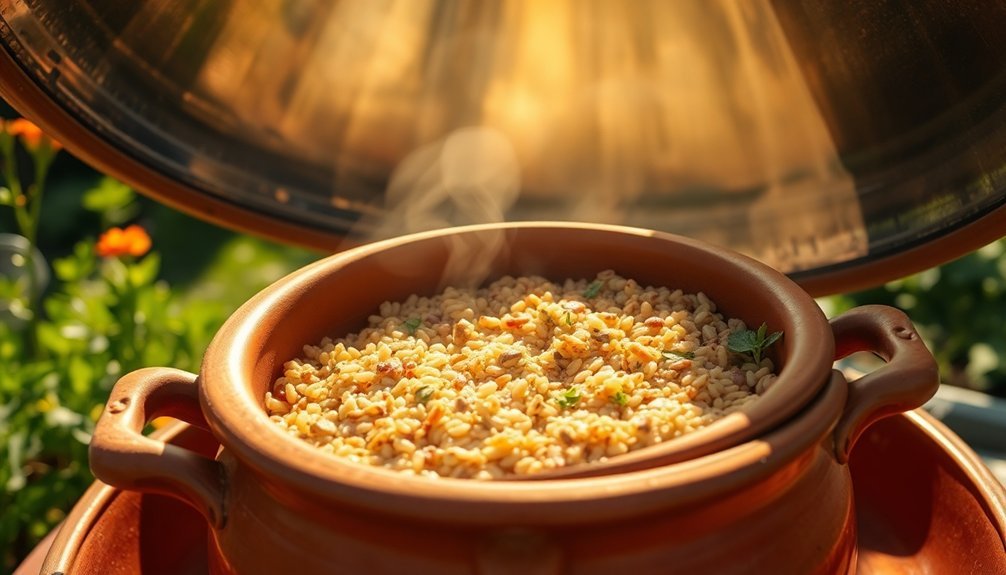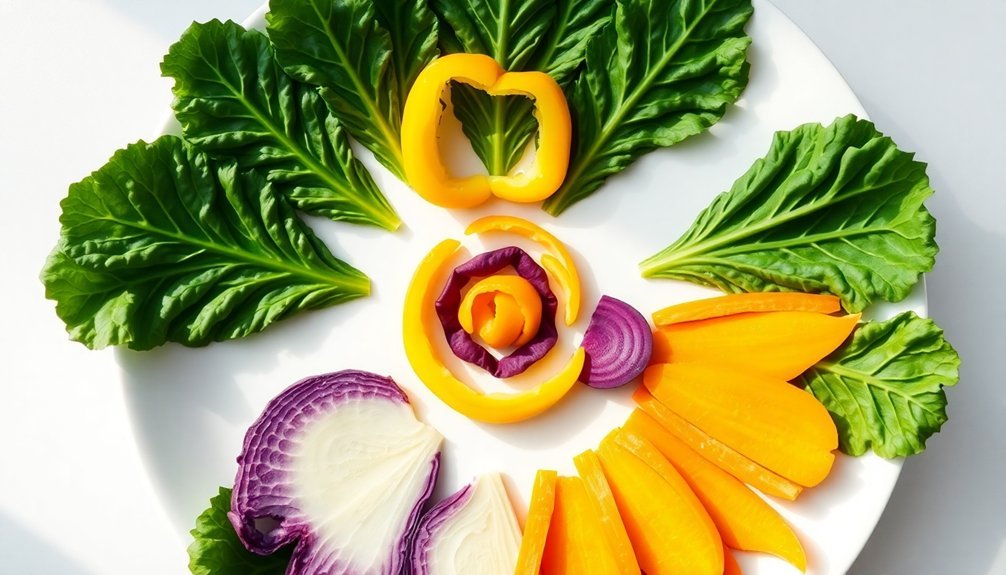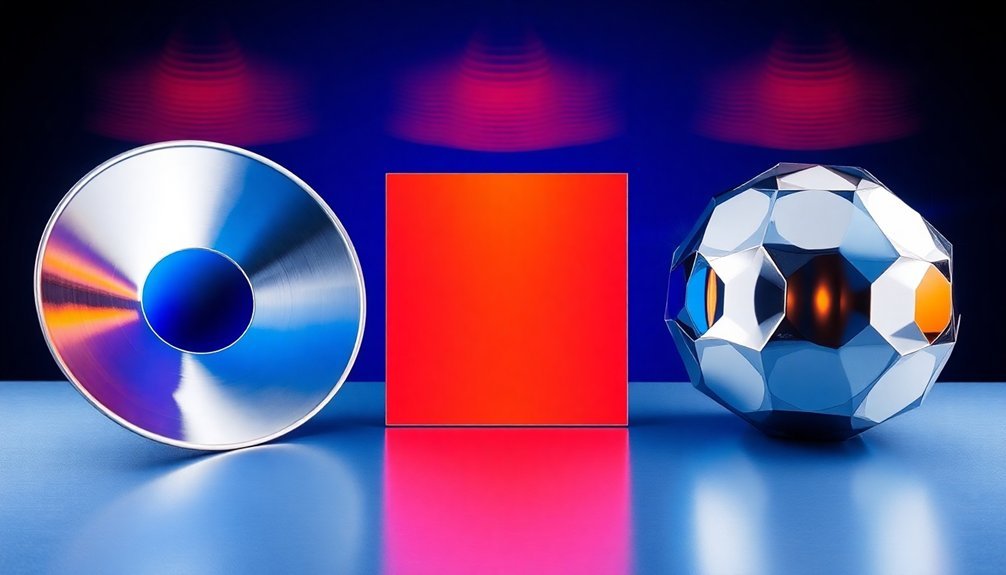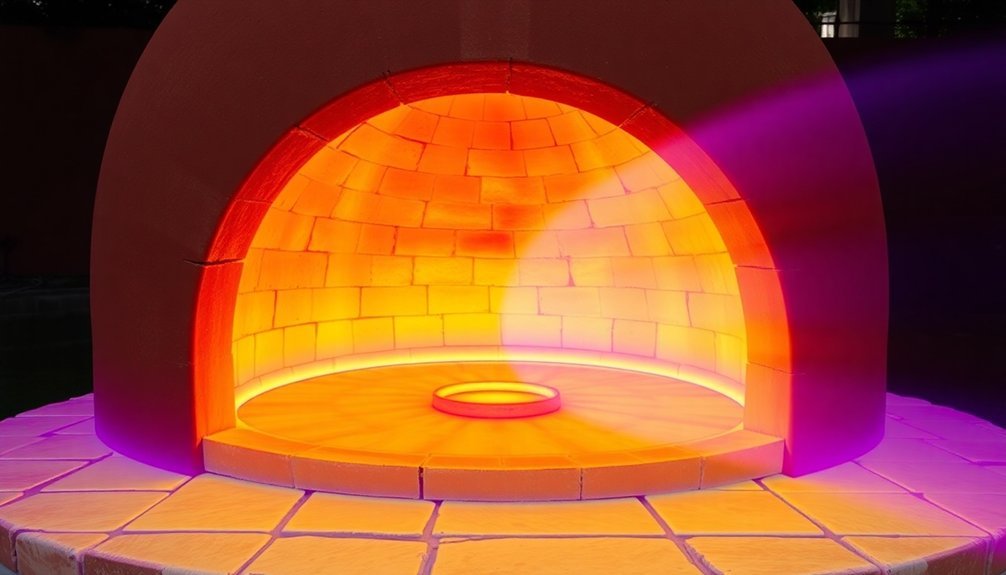Success with solar-powered multi-grain cooking starts with proper setup and timing. You'll need a basic solar oven made from a cardboard box, lined with black paper, and sealed with clear plastic wrap. Choose beginner-friendly grains like white rice, rolled oats, or pearl barley, and stick to the 11 AM to 3 PM timeframe for best results. Monitor your oven's temperature, aiming for 178°F before adding grains, and maintain temperatures between 200-300°F during cooking. Follow basic water-to-grain ratios (2:1 for rice, 4:1 for lentils) and adjust based on altitude. The journey to becoming a solar cooking expert holds many more tasty discoveries.
Essential Solar Oven Setup

Building a solar oven starts with preparing a basic cardboard box structure and adding essential components for heat absorption and retention. You'll need a cardboard box with a lid that's at least 3 inches deep, such as a pizza box or nested boxes. Cut a three-sided flap in the lid, leaving a 1-inch border, and make sure to clean the box thoroughly before use.
Line the bottom with black construction paper to maximize heat absorption, or paint the inner surface black. You'll want to create an insulation layer using crumpled newspapers or cotton padding between the inner and outer boxes. The crumpled newspapers help maintain consistent cooking temperatures throughout the box.
For the window, seal the opening with two layers of clear plastic wrap on both sides of the lid, or use glass or Plexiglas for better heat retention. Cover the inner side of the flap with aluminum foil, shiny side out, to reflect sunlight into the box.
Add a heat-resistant cooking rack, positioning it at least 2 inches above the bottom surface. Finally, preheat your oven for 30 minutes in direct sunlight when outdoor temperatures reach 85°F, aiming for an internal temperature of 178°F before cooking.
Grain Selection and Preparation
When you're choosing grains for your solar oven, select options like white rice, rolled oats, and pearl barley that cook well with slow, steady heat.
You'll want to pay special attention to each grain's required moisture content, as proper water ratios are essential for achieving the right texture in solar cooking. Consider using the absorption method where grains are covered with a measured amount of liquid until fully cooked.
For best results, start with grains that have predictable cooking times and clear water-to-grain ratios, which will help you master the basics of solar cooking before moving on to more challenging options.
Best Grains for Sunbaking
Selecting the right grains for sunbaking can make or break your solar cooking success. You'll find that four grains stand out for their unique characteristics and adaptability to sun-powered preparation: amaranth, barley, millet, and sorghum.
Amaranth's high protein content and distinctive spicy flavor make it an excellent choice for sunbaking, and you can even pop it like popcorn before drying. The complex carbohydrates in whole grains provide sustained energy throughout the day. If you're gluten-sensitive, you'll want to focus on amaranth, millet, or sorghum, as barley contains gluten.
Millet's hardy nature and versatility let you season it and form it into patties, while sorghum's low water requirements and high nutritional profile make it an environmentally conscious choice.
When you're working with these grains, spread them in thin layers between 2-4 cm and mix them every 30 minutes. You'll need to monitor temperatures carefully, covering your grains when they exceed 50ºC.
For ideal results, soak or sprout barley before sun exposure, thoroughly rinse quinoa, and consider roasting sorghum after drying. Remember to store your sun-dried grains at 18% moisture content in well-ventilated areas for the best preservation.
Moisture Content Matters Most
In accordance with successful sun-powered cooking, proper moisture content serves as the cornerstone of grain preparation and storage. You'll need to monitor moisture levels carefully, as each grain type requires specific conditions for ideal results. For wheat and corn, aim for 13.5% moisture content, while soybeans need 11%, and sunflowers require 8-10%.
Before you begin sun cooking, verify your grains have reached room temperature by storing them in sealed plastic bags. You'll want to spread them in thin layers of 2-4 cm for even heating and stir every 30 minutes. This prevents moisture gradients and guarantees uniform cooking outcomes.
Watch for signs of overheating, which can crack your grains and reduce quality. If you're cooking on particularly hot days, cover your grains during peak sun hours.
You'll need to protect them from rain, animals, and ground moisture to maintain proper consistency. Remember that higher moisture levels combined with warm temperatures considerably reduce storage life and can promote mold growth.
Keep checking moisture content throughout the cooking process to achieve the best results in your sun-powered cooking adventure.
Best Times for Solar Cooking

You'll find the most success with solar cooking between 11:00 am and 3:00 pm, when the sun is directly overhead and provides maximum heat.
Plan your cooking around these peak hours, knowing you'll need about twice the cooking time compared to conventional ovens, especially on bright, cloudless days.
Checking your local weather forecast helps you schedule ideal cooking times, as even thin clouds can extend your cooking duration and affect the 200-300°F temperatures your solar oven can reach.
Peak Sunshine Hours
Finding the right time to use your solar cooker can make all the difference in cooking success. You'll get the best results between 10:00 am and 2:00 pm when the sun's position provides maximum UV rays and heat. During summer months, you can extend your cooking window from 8:00 am to 6:00 pm, while winter requires you to stick to shorter peak hours.
For ideal performance, you'll need to position your cooker directly facing the sun and adjust it frequently, especially during shorter winter days. Using reflectors can boost your cooking power by directing additional sunlight onto your cooking container.
| Time of Day | Summer Performance | Winter Performance |
|---|---|---|
| 8:00-10:00 | Good | Poor |
| 10:00-2:00 | Excellent | Good |
| 2:00-4:00 | Good | Poor |
| 4:00-6:00 | Fair | Not Recommended |
Before starting, check that objects cast clear shadows on the ground – this indicates sufficient sunlight for cooking. You'll want to preheat your solar oven and start early, particularly during winter months. Remember that cooking times typically double compared to conventional ovens, so plan accordingly when preparing your meals.
Weather-Based Solar Planning
Building on the importance of peak sunshine hours, successful solar cooking depends heavily on weather conditions and location. You'll need direct sunlight for your solar oven to work effectively, so plan your cooking between 10 a.m. and 2 p.m. when the sun's rays are strongest.
If you live in cloudier regions like Oregon or Minnesota, you'll want to be more strategic with your cooking schedule. Monitor your local weather forecast and plan your solar cooking for clear, sunny days.
During summer, you'll have longer cooking windows and more intense sunlight, making it ideal for most recipes. Winter cooking requires more patience – you'll need to start earlier and might've to split cooking over multiple days due to shorter daylight hours and the sun's lower position.
For best results, preheat your oven for at least 30 minutes and adjust it frequently to track the sun's movement. If you're in an area with variable weather, use dark-colored pots and add thermal mass like a brick to maintain consistent heat.
Don't forget to angle your reflectors properly – about 30 degrees in summer and 60 degrees in winter if you're in the Northern Hemisphere.
Temperature Control and Monitoring
Successfully controlling temperature in a solar oven requires three essential monitoring tools: a reliable digital probe thermometer, a built-in oven thermometer, and a meat temperature chart.
You'll need these to maintain safe cooking temperatures between 200°F and 300°F while ensuring your food reaches proper internal temperatures: 145°F for whole cuts, 160°F for ground meats, and 165°F for poultry.
For accurate readings, you'll want to use buffered probe sensors rather than relying on air temperature alone.
Position your solar oven in direct sunlight between 11 AM and 3 PM, and monitor real-time temperature changes at different points in the oven.
Remember that cooking times typically double compared to conventional methods.
You can enhance your temperature monitoring by using modern solar oven apps that track both temperature changes and solar position.
Don't forget to account for environmental factors like wind and cloud cover, as they'll affect your readings.
Keep your cookware covered with dark-colored, tight-fitting lids to minimize heat loss, and regularly adjust your reflectors to maintain consistent temperatures throughout the cooking process.
Adjusting Water Ratios

With your temperature monitoring system in place, let's focus on water measurements for your solar cooking success. You'll need to master specific water-to-grain ratios to achieve the perfect texture in your solar-cooked meals. Start with these basic proportions: use 2:1 water-to-grain ratio for rice and quinoa, 4:1 for lentils and beans, and 2:1 for oats.
Keep in mind that you'll need to adjust these ratios based on several factors. Your location's altitude and climate can affect water requirements – higher altitudes often need more water.
Your solar cooker's efficiency will also impact how much moisture your grains retain during cooking. If you're aiming for softer grains, add slightly more water; for firmer results, reduce it.
Don't hesitate to experiment with small batches first. Watch your food through a clear plastic bag or transparent heat trap, and take notes on what works best. If your first attempt isn't perfect, adjust the ratio in your next cook.
Remember to maintain consistent measurements – this helps you refine your technique over time. Once you've found your ideal ratios, you'll consistently produce perfectly cooked grains and legumes.
Storage and Serving Tips
Safe handling practices guarantee your solar-cooked meals reach the table in perfect condition. When removing food from your solar cooker, always use pot holders to prevent burns and place the pot on a heat-resistant surface. Let the food rest briefly to confirm even heat distribution before you serve it.
| Storage Method | Best For | Duration |
|---|---|---|
| Insulated Container | Hot Meals | 2-3 hours |
| Vacuum Flask | Soups/Liquids | 4-6 hours |
| Airtight Container | General Foods | 1-2 days refrigerated |
| Zip-lock Bags | Reheating | Same day |
| Freezer Storage | Long-term | 1-3 months |
For immediate serving, transfer your food directly from the cooker to pre-heated, temperature-resistant serving dishes. You'll get the best flavor and temperature this way. If you're storing leftovers, use insulated containers for hot foods or refrigerate them promptly. When it's time to reheat, you can place leftovers back in the solar cooker using heat-conducting containers covered with clear plastic bags. For even heating, rotate solid foods every 10-15 minutes. Don't forget to keep stored food away from direct sunlight if you're not serving it right away.
Frequently Asked Questions
Can Solar Ovens Work Effectively on Cloudy or Partially Overcast Days?
Yes, you'll find solar ovens can work on cloudy days, but they're less efficient. Your cooking times will be longer, and you'll get better results with slow-cooking foods like beans and potatoes at 225-300°F.
How Do Different Colored Grains Affect Cooking Times in Solar Ovens?
The color of your grains won't greatly affect cooking times. It's the color of your cookware that matters most. You'll get better results using dark-colored pots or dishes to absorb more solar energy.
What Happens if the Solar Oven Gets Knocked Over During Cooking?
If your solar oven gets knocked over, you'll lose heat quickly, risk spilling hot food, and possibly damage components. You'll need to check for breakage, reset the reflectors, and restart cooking from the beginning.
Can Multiple Types of Grains Be Cooked Simultaneously?
You can cook multiple grains together if they have similar cooking times. Mix brown and wild rice, or combine farro with barley and spelt. Avoid mixing grains with vastly different cooking durations.
Do Solar-Cooked Grains Retain More Nutrients Than Conventionally Cooked Ones?
Yes, you'll get more nutrients from solar-cooked grains. They retain higher levels of protein, calcium, and iron compared to conventional cooking. You'll preserve up to 99% of proteins and essential minerals using solar cooking.
In Summary
You've now learned the fundamentals of solar cooking grains successfully. Whether you're preparing quinoa, rice, or barley, you'll find that sun-powered cooking offers an eco-friendly way to prepare your favorite grains. Remember to monitor weather conditions, maintain proper temperatures, and adjust water ratios as needed. With practice, you'll master this sustainable cooking method and enjoy perfectly cooked grains every time.





Leave a Reply